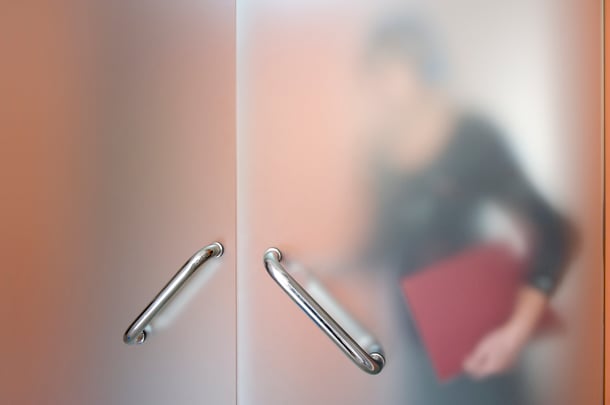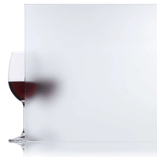 Incorporating obscure glass in a commercial glass project is a hallmark of style and functionality.
Incorporating obscure glass in a commercial glass project is a hallmark of style and functionality.
These glass types provide elegant solutions to balancing natural light with privacy.
However, be sure to be clear with your glass manufacturer about what type of glass your project needs.
Terminology can be confusing, especially when you’re an industry outsider. Some customers ask for frosted glass when they really mean patterned glass. Since there are major differences between acid-etched glass and Seedy patterned glass, you’ll want to ensure you and your manufacturer are discussing the same thing.
Let’s compare obscured glass to get a sense of what your commercial project needs.
What is Obscure Glass?
Obscure glass is glass that has been treated to make it less transparent. This can be done for a variety of reasons, such as to provide privacy, reduce glare, or create a decorative effect. There are many different types of obscure glass available, each with its own unique properties.
Types of Obscure Glass
Obscure glass is a catch-all term that includes:
- Frosted Glass
- Patterned Glass
- Obscure Glass
- Etched Glass
- Satin Glass
Frosted Glass
Frosted glass, one of the most common types of obscure glass, is made by acid-etching the surface of the glass (more on that below). This creates a pitted texture, which allows light to pass through the glass but makes it difficult to see through clearly. Frosted glass is often used in bathrooms, showers, and other areas where privacy is desired.
Frosted and acid-etched are nearly synonymous, but be sure you and your glass fabricator understand your request in the same way.
Patterned Glass
Patterned glass is made by pressing a pattern into the surface of the glass while it is still hot. Patterns can be simple or complex and used to create various effects. Patterned glass is often used in decorative applications, such as in stained glass windows and shower screens.
Etched Glass
Etched glass is made by using an etching cream or acid to create a design on the surface of the glass. Etched glass can be used to create various effects, from simple monograms to complex works of art.
Satin Glass
Satin glass is made by acid-etching the surface of the glass until it has a smooth, satin-like finish. Satin glass is often used in commercial applications, such as in-office partitions and conference rooms.
What Does My Glass Manufacturer Hear When I Say ‘I Want Frosted Glass?’
You tell your glass manufacturer, “I’d like to use frosted glass for this project.”
While you may have a complete idea of what you want, your glass manufacturer doesn’t yet have all the information. What does frosted glass mean to you? And what does it mean to your manufacturer? These might be two different things.
A good commercial glass manufacturer will likely ask follow-up questions to ensure you are both discussing the same thing.
Good communication will prevent you from asking for this (Seedy patterned glass):
And getting this (Acid-etched glass):
Both glass types work well for several applications. However, you want the glass type that best fits your needs.
Looking for a Commercial Glass Partner?Make sure you and your glass manufacturer are on the same page. Download our Guide to Partnering with a Commercial Glass Company: |
Comparing Frosted Glass & Patterned Glass
While both frosted glass and patterned glass offer unique aesthetics and benefits, understanding the differences between them can open new design possibilities. Here’s a look at how these glass types are made and where you might find them:
How Frosted/Acid Etched Glass is Made
Frosted/acid-etched glass stands out for its smooth, satin-like finish that diffuses light and reduces glare while maintaining substantial natural light. Its manufacturing process involves:
- Preparation: Clear glass sheets are carefully prepared for the etching process. The glass is cleaned and inspected to ensure it's free of imperfections or blemishes.
- Etching: Hydrofluoric acid, a highly reactive substance, is applied to the glass surface. The level of translucency can be controlled by adjusting the concentration of the acid and the duration of its application. This step creates the desired smooth, frosted appearance.
- Cleaning: Once the desired effect is achieved, the glass undergoes a thorough cleaning process. This not only stops the acid's reaction but also removes any residual acid, ensuring safety and longevity. NOTE: When cleaning acid-etched glass, water will temporarily make it slightly clear.
- Final Product: The result is durable, scratch-resistant glass with a uniform, smooth surface. Unlike frosted glass, acid-etched glass is known for its resistance to smudges and ease of cleaning and maintenance.
How Patterned Glass is Made
Patterned glass is a versatile and attractive material that can be used to add privacy, reduce glare, or create a decorative effect in your home or office. Its manufacturing process involves:
- Raw materials: The raw materials for patterned glass are the same as for regular glass: silica sand, soda ash, and lime. These materials are melted together in a furnace to create molten glass.
- Forming the pattern: The molten glass is then passed through a pair of rollers that have been engraved with the desired pattern. The rollers press the pattern into the glass, creating a raised or indented design.
- Annealing: After the glass has been patterned, it is annealed in a lehr. The lehr is a long furnace that cools the glass slowly and evenly. This process helps to prevent the glass from cracking or breaking.
- Cutting and inspection: Once the glass has been annealed, it is cut to size and inspected for defects. The patterned glass is then ready to be used in a variety of applications.
Applications
The unique properties of frosted glass and patterned glass make them versatile choices for a wide range of applications, each catering to specific needs in terms of texture, maintenance, and aesthetic appeal.
While different, frosted glass and patterned glass ultimately achieve the same result, diffusing light and obscuring visibility.
Frosted glass and patterned glass can be found in:
1. Interior Design
- Shower enclosures
- Room partitions
- Glass furniture tops
- Bathroom windows
- Interior doors
- Mirrors
- Decorative features
2. Architectural Applications
- Exterior windows
- Facades
- Balustrades
3. Commercial Settings
- Signage
- Decorative panels
- Office partitions
- Meeting rooms
- Lighting fixtures
Visible Light Transmission (VLT)
Keep in mind that both frosted and patterned glass affect visible light transmission (VLT) – the amount of visible sunlight that can pass through the glass. Higher VLT values allow more natural light, creating brighter and naturally lit spaces.
Understanding VLT is crucial when selecting the right glass type for your project, as it can significantly impact the ambiance and functionality of a space.
|
White Laminated Glass — A Possible Alternative
When your clients are seeking an obscured glass solution that offers a unique alternative to frosted or patterned glass, consider introducing them to white laminated glass. This option provides a smooth finish on both sides and is remarkably user-friendly, making it a compelling choice for designers and contractors alike.
Key Features of White Laminated Glass
One of the standout features of white laminated glass is its smooth surface on both sides. This attribute lends a sleek and modern aesthetic to any space where it is employed.
All laminated glass, regardless of color, is renowned for its strength and safety. Composing multiple layers of glass bonded together with an interlayer, typically made of polyvinyl butyral (PVB), it’s not only robust but also shatter-resistant – a valuable safety consideration.
White laminated glass is as easy to work with as frosted glass, making it a seamless choice for designers and contractors. It can be cut, shaped, and installed in various applications just like traditional glass options.
Frosted Glass or Patterned Glass?
In its various forms, obscured glass is a conduit for architects and designers to bring their visions to life, balancing the interplay of light, privacy, and aesthetic beauty in innovative ways.
Frosted glass, with its smooth, consistent, and stain-resistant surface, is particularly beneficial for high-traffic areas or surfaces that need frequent cleaning. On the other hand, patterned glass is a stylish and practical way to enhance the privacy, brightness, and elegance of any space.
Choosing between frosted and patterned glass ultimately depends on a project’s specific needs for texture, maintenance, and visual appeal.
See What We Offer
We have a wide array of obscured glass and patterned glass choices. View our catalog:





